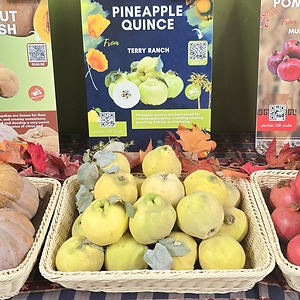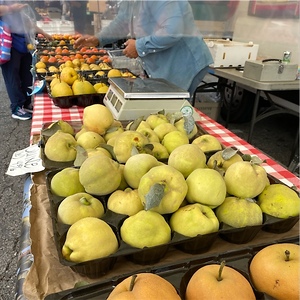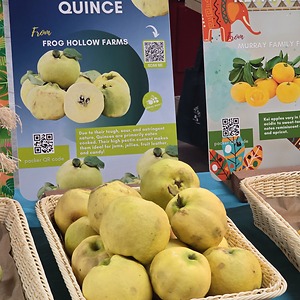


Pineapple Quince
Estimated Inventory, 18 lbs : 0
Description/Taste
Pineapple quinces are medium to large fruits, averaging 7 to 10 centimeters in diameter, and have a uniform, round to ovate shape with a small and curved, raised neck. The skin is firm, smooth, thin, and delicate, easily bruised, and has a bumpy texture, ripening from green to a golden, lemon yellow when mature. It is important to note that the skin will remain firm when ripe and will develop a musky, tropical, and floral scent with notes of lemon and apple. Underneath the surface, the flesh is white, dense, and dry, encasing a central core filled with dark brown seeds. Pineapple quinces have a sweet-tart, mildly astringent flavor when raw, softening in texture when cooked, developing deeper fruity undertones reminiscent of the tartness of oranges and limes, the acidity of pineapples, and the sweet taste of pears and apples.
Seasons/Availability
Pineapple quinces are available in the mid-fall through winter.
Current Facts
Pineapple quinces, botanically classified as Cydonia oblonga, are an early-maturing, American variety belonging to the Rosaceae family. The aromatic fruits were developed in the late 19th century by Luther Burbank in California and were one of the first quince varieties to be bred with the capacity to be eaten fresh when ripe. Pineapple quinces are known for their high pectin content and are popularly used to make jams, jellies, sauces, and pastes. The fruits are produced in limited commercial quantities in California and are the most common cultivar seen in local supermarkets and farmer’s markets within the state. Outside of California, the variety is reserved as a rare home garden variety.
Nutritional Value
Pineapple quinces are a good source of copper to boost the metabolism and vitamin C, an antioxidant that strengthens the immune system, increases collagen production within the skin, and reduces inflammation. The fruits also provide vitamin A, iron, magnesium, and potassium and contain smaller amounts of fiber to regulate the digestive tract.
Applications
Pineapple quinces are best suited for cooked applications, including stewing, poaching, baking, or simmering. The aromatic fruits were bred to be eaten raw, but the flavor is still somewhat tart with an astringent mouthfeel, leading many consumers to solely use it in cooked applications. Pineapple quinces, like other quince varieties, are famously used to make marmalade, jams, and jellies. The floral, sweet-tart spreads can be served on cheese plates, slathered onto toast, or paired with fresh baked goods. The fruits can also be baked with other fruits into pies and crumbles, cooked into braising sauces to pour over roasted meats, incorporated into stews, or juiced and mixed into ciders. It is important to note that the pale-yellow flesh will transform into a pale pink to crimson-purple hue once cooked, also softening in texture, developing an applesauce-like consistency. Pineapple quinces can be poached in sugar syrup and spooned over ice cream, oatmeal, or granola. The sweet syrup can also be reused and incorporated into cocktails or drizzled over cakes and other desserts. Pineapple quinces pair well with fruits such as apples, pears, raspberries, apricots, oranges, cranberries, and grapes, coffee, ginger, rosemary, cinnamon, meats such as pork, cheeses such as idiazabal, manchego, and petite basque, butternut squash, cabbage, fennel, and turnips. Whole, unwashed Pineapple quinces can be stored at room temperature until ripe. Once mature, the fruits can be stored for two weeks in an unsealed plastic bag in the refrigerator.
Ethnic/Cultural Info
Quince is used to make traditional dulce de membrillo, or quince paste. The jam-like spread is made from simmering quince with sugar, and the natural pectin content within the pulp contributes to the thickening of the paste, creating a creamy consistency with a sweet-tart flavor. Dulce de membrillo is traditionally sliced into thin squares and is served on cheese boards alongside manchego or other salty, hard cheeses. It is also spread on crostini with savory prosciutto and blue cheese and often paired with wines. The paste can be served as an appetizer, afternoon snack, or dessert, and beyond cheese plates, dulce de membrillo is frequently incorporated into baked goods. Dulce de membrillo is viewed as a specialty item and was created in Spain sometime during the 4th or 5th century. In the modern-day, the paste has also become favored in South America, Central America, and Mexico, traditionally served during special occasions, dinner parties, and holiday gatherings.
Geography/History
Pineapple quinces were developed by Luther Burbank in the 1880s in Central California. Burbank sought to produce a quince variety with the ability to be eaten fresh without the need for cooking. He also wanted the variety to have a faster cooking time than existing cultivars with improved flavor. It took Burbank almost twenty years to create Pineapple quinces through natural crosses and selective breeding, and the fruits were released to growers in 1899. Today, Pineapple quinces are the most commercially produced variety in California and are primarily grown in the state’s central San Joaquin Valley for sale through select grocers and farmer’s markets. The cultivar is also cultivated to a limited extent in temperate parts of the United States, South America, and Australia.
Recipe Ideas
Recipes that include Pineapple Quince. One

















